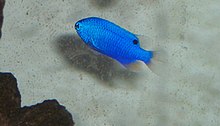| Chrysiptera cyanea | |
|---|---|

| |
| Scientific classification | |
| Domain: | Eukaryota |
| Kingdom: | Animalia |
| Phylum: | Chordata |
| Class: | Actinopterygii |
| Family: | Pomacentridae |
| Genus: | Chrysiptera |
| Species: | C. cyanea
|
| Binomial name | |
| Chrysiptera cyanea | |
| Synonyms | |
|
List
| |
Chrysiptera cyanea is a species of damselfish found in the wide Indo-West Pacific but not known in the Red Sea.[2] A few individuals were observed in the Mediterranean Sea in 2013 off Slovenia, a likely aquarium release.[3]
Common names include blue damselfish, blue demoiselle, blue devil, cornflower sergeant-major, Hedley's damselfish, red tail Australian damsel, sapphire devil, and sky-blue damsel.[4]
Wikimedia Commons has media related to Chrysiptera cyanea.
Wikispecies has information related to Chrysiptera cyanea.
- ^ Allen, G.R.; Arceo, H.; Mutia, M.T.M.; Muyot, F.B.; Nañola, C.L. & Santos, M. (2022). "Chrysiptera cyanea". IUCN Red List of Threatened Species. 2022: e.T188435A1874753. doi:10.2305/IUCN.UK.2022-2.RLTS.T188435A1874753.en. Retrieved 1 January 2024.
- ^ Froese, Rainer; Pauly, Daniel, eds. (2011). "Chrysiptera cyanea". FishBase.
- ^ Atlas of Exotic Fishes in the Mediterranean Sea (Chrysiptera cyanea). 2nd Edition. 2021. 366p. CIESM Publishers, Paris, Monaco. https://ciesm.org/atlas/fishes_2nd_edition/Chrysiptera_cyanea.pdf
- ^ Froese, R.; Pauly, D., eds. (2011). "Common names of Chrysiptera cyanea". FishBase.
